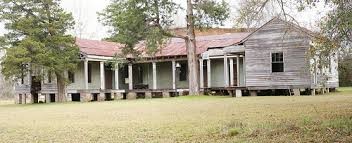Keatchie Women's College -- Keatchie, Louisiana
Introduction
Text-to-speech Audio
Images
A monument to the old Women's College of Keatchie

Backstory and Context
Text-to-speech Audio
Shortly following the Battle of Mansfield on April 08, 1864, Keatchie Women’s College located on Highway 172 (Mansfield Road) in Keatchie, Louisiana was transformed into a make-shift hospital, Where the 2nd floor was used to aid and treat many of the Confederate soldiers wounded during the battle. Many of the soldiers that lost their lives in the temporary hospital were buried in the Confederate Cemetery located nears the Women’s College.
Foundation of Keatchie Women’s College
Keatchie is located in Desoto, Parish roughly 15 miles northwest of Mansfield and 20 miles southwest of Shreveport. The small hamlet of Keatchie was once the home of Baptist, Methodist and Presbyterian churches and their congregations. Under the leadership of Pastor A. N. Backus, the parishioners of New Hope Baptist Church contributed to and established one of the first public buildings in the area. Backus fought to bring culture to the town of Keatchie—by encouraging the development of a college with a Christian emphasis. His reasoning centered on the citizens of the area being able to have access to a proper education with the help and guidance from the local church and community. In the process of organizing ideas for a school, Backus was accompanied with T. M. Gatlin, who had donated land and was a prominent Planter at the time who sought supporters needed to finance Backus’s ultimate goal.
When Backus’s family died,
he relocated his home state of Kentucky and left Gatlin to finish his dream.
Keatchie College was constructed on land granted by Gatlin in 1856 and for a
while associated with the Baptist Union Male and Female College. The benefactor
and guardianship was administered by the Grand Cane Association, which consisted
of a small cluster of members of Baptist churches across Northwest Louisiana.
Women's colleges predominated in the antebellum South as centers of cultural transmission, instructing women in a variety of academic and vocational types of instruction. At antebellum women's colleges, many learned the etiquette and expectations required for social acceptance. In other words, these schools taught women how to host a party in addition to Greek philosophy and European literature, how to wear their hoop skirts, and win the affection of high class men. As with Keatchie and many other such women's colleges in the South, these educational spaces provided access to culture on a frontier where the white population was sparse.
Begun just five years before hostilities erupted in the American Civil War, many of Keatchie's female students probably realized that learning to be a "southern Belle" had little utility in a landscape ravaged by war, Yankee occupation, and Confederate supply raids. Historian Giselle Roberts explains that the women at Keatchie certainly knew that the war was going to end southern culture as they knew it.
The heavy hand of war, seemingly remote at first, made its impact in the immediate vicinity with the Red River Campaign and the Battle of Mansfield—fought in April 1864. Financial problems began to affect the sponsors and leaders of the College, and for approximately an entire school year, classes were suspended. After the battle near Mansfield, the College then became a temporary hospital where the second floor of the main academic and administration building was used for the recovery of the wounded, or to comfort dying soldiers who had been injured in the battle. Many of the soldiers who died were interred at the Confederate Cemetery not far from the school.
A public school operated for a number of years in what had been the College building, which was later destroyed. The building currently standing is a replica monument to the building that was constructed in 1856. The monument structure was donated to the Keatchie Heritage Foundation, which closely works with the United Daughters of the Confederacy (UDC) and the Historic Preservation Fund under the leadership of Leslie. P. Tassin, for preservation and renovation purposes. Now, the building stands empty, and the village of Keatchie has no school.
We can clearly gather that the ultimate goal behind organizations such as the UDC is to define their social identity and to construct historical narratives consistent with that Confederate identity. The organization’s memorialization processes and methods, and the aftermath, helps constitute a vital part of both individual and local or regional identity. The UDC operated for years in the South, constructing not only monuments, but an alternate accounting of the Southern past—one in which heritage replaces history—and thereby conceals the real intent behind the South’s rebellion and failed Confederate nation. As historian Joan Marie Johnson argues in a recent book on the UDC and clubwomen in the South, they constructed a version of the past that would fit their segregationist present and support their society's racial discriminatory practices.Sources
2. Roberts, Giselle . "The Confederate Belle: The Belle Ideal, Patriotic Womanhood, and Wartime Reality in Mississippi and Louisiana, 1861-1865. Louisiana History (Spring 2002): 189-214.
3. Wilson, Charles Reagan. “The Religion of the Lost Cause: Ritual and Organization of the Southern Civil Religion 1865-1920.” The Journal of Southern History, (May 1980): 1–21.
4. The Boardman. "Early Schools & Colleges of Louisiana." Louisiana School Board Assocation, June 1961. Louisiana State University.
